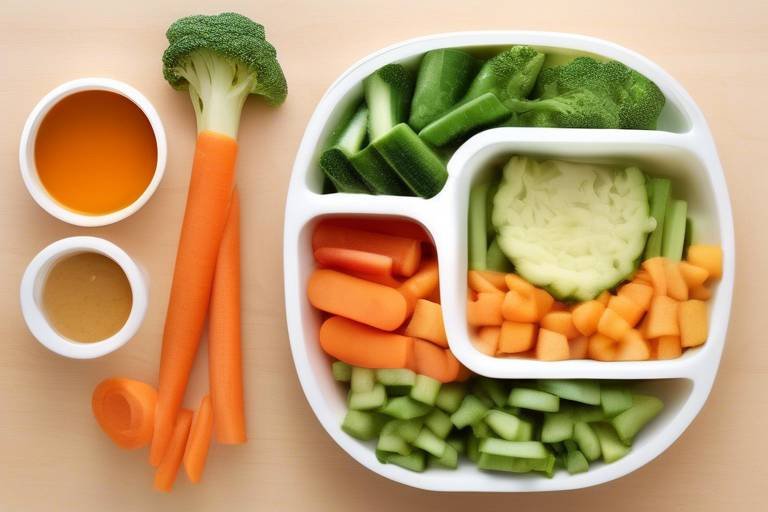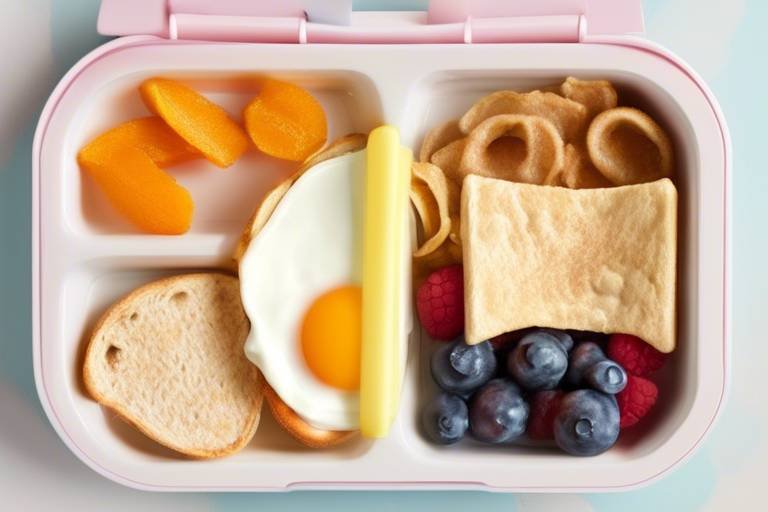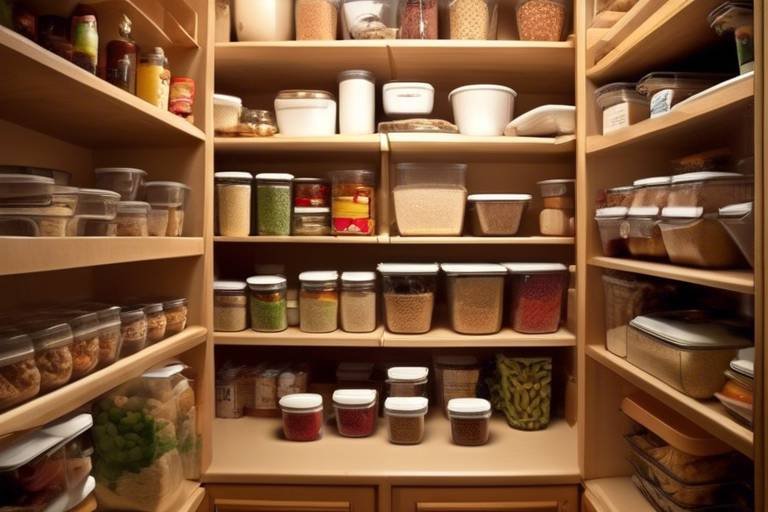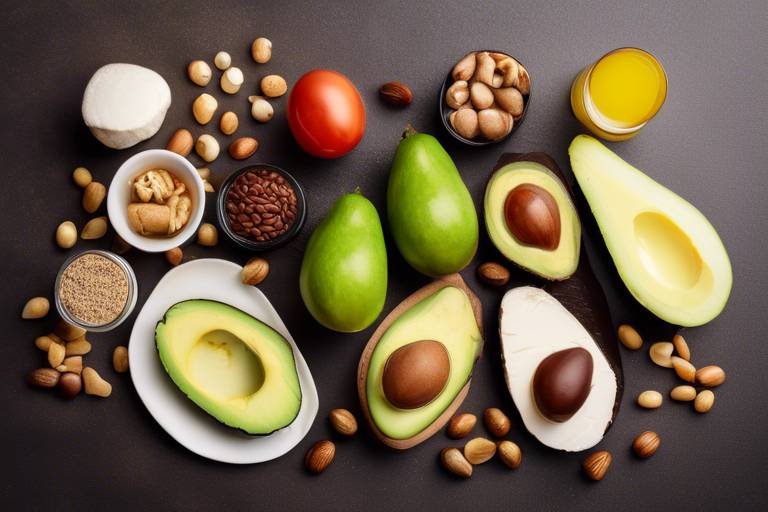Why Fiber is Important in Your Child's Diet
As parents, we often find ourselves pondering the best ways to ensure our children grow up healthy and strong. One of the most overlooked aspects of a child's diet is fiber. You might be wondering, why is fiber so crucial? Well, fiber is like the unsung hero of nutrition, quietly working behind the scenes to support various bodily functions. It’s not just about keeping things moving in the digestive tract; fiber plays a pivotal role in overall health, helping to stave off issues like constipation, obesity, and even diabetes.
Imagine your child's digestive system as a well-oiled machine. Fiber acts as the lubricant—keeping everything running smoothly. In fact, studies have shown that children who consume adequate amounts of fiber tend to have better weight management and lower risks of chronic diseases as they grow. But how much fiber do kids actually need? The recommended daily intake varies by age, but generally, children should aim for a minimum of 14 grams of fiber for every 1,000 calories consumed. This means that as their caloric intake increases with age, so does their fiber requirement.
Incorporating fiber into your child's diet isn't just about meeting a number; it's about fostering healthy eating habits that can last a lifetime. By introducing fiber-rich foods early on, you’re setting the stage for your child to make informed food choices as they grow. So, what are some simple and delicious ways to add more fiber to their meals? Let’s explore some practical strategies that can make fiber a fun and tasty part of your child’s diet!

Understanding Dietary Fiber
This article explores the significance of fiber in children's nutrition, its health benefits, and practical ways to incorporate it into their daily meals for optimal growth and development.
Dietary fiber is not just a buzzword in nutrition; it's a vital component of a balanced diet that plays a significant role in maintaining health, especially for growing children. Think of fiber as the unsung hero of the food world—it’s the part of plant foods that our bodies can’t digest, but it’s essential for keeping everything running smoothly. Fiber can be divided into two main types: soluble fiber and insoluble fiber, each serving distinct functions in the body.
Soluble fiber dissolves in water and forms a gel-like substance in the gut. This type of fiber can help lower blood cholesterol and glucose levels, making it particularly beneficial for children who may be prone to energy spikes and crashes. Foods rich in soluble fiber include:
- Oats
- Beans
- Apples
- Citrus fruits
On the other hand, insoluble fiber does not dissolve in water. Instead, it adds bulk to the stool and helps food pass more quickly through the stomach and intestines. This is crucial for preventing constipation, a common issue among children. Foods high in insoluble fiber include:
- Whole grains
- Nuts
- Vegetables like carrots and broccoli
Incorporating both types of fiber into your child's diet is essential for their overall health. It’s like having a well-rounded team; each player has their strengths that contribute to the game. By ensuring your child gets a mix of soluble and insoluble fiber, you’re setting them up for success in their health journey.
Moreover, fiber is a key player in promoting a healthy gut microbiome, which is increasingly recognized as a cornerstone of good health. A diverse diet rich in fiber can help cultivate a thriving community of beneficial bacteria in the gut, which can aid in digestion, boost the immune system, and even improve mood. So, when you think about fiber, think of it as a superhero for your child’s digestive system!
Lastly, it’s important to note that while fiber is incredibly beneficial, it’s best to introduce it gradually into your child’s diet. Sudden increases in fiber can lead to discomfort, such as bloating or gas. Just like a marathon runner wouldn’t start by running a full marathon, your child should gradually adapt to higher fiber intake. This will not only help them enjoy the benefits of fiber but also make the transition smoother and more enjoyable.
Fiber offers numerous health benefits for children, including improved digestion, enhanced satiety, and better blood sugar control. Understanding these benefits can help parents prioritize fiber in their child's diet.
Fiber plays a vital role in maintaining healthy digestion. It helps prevent constipation and promotes regular bowel movements, which are essential for children's overall health and comfort.
There are two main types of fiber: soluble and insoluble. Each type has unique effects on digestion and health, making it important to include a variety in children's diets.
Recognizing signs of digestive issues in children, such as bloating or irregular bowel movements, can prompt dietary adjustments. Increasing fiber intake may alleviate these problems effectively.
Incorporating fiber-rich foods into meals can help establish healthy eating habits from an early age. Teaching children about the importance of fiber can encourage them to make better food choices.
Identifying fiber-rich foods that children enjoy can make it easier to incorporate more fiber into their diets. This section highlights various delicious options that appeal to young taste buds.
Fruits and vegetables are excellent sources of fiber. Encouraging children to eat a colorful variety can boost their fiber intake while providing essential vitamins and minerals.
Whole grains and legumes are packed with fiber. Introducing these foods into meals can significantly enhance fiber content, promoting better health and well-being for children.
Parents can use various strategies to increase fiber in their child's diet. This section offers practical tips for making fiber-rich foods more appealing and accessible to kids.
Creating fun and tasty meals that include fiber can make eating healthy enjoyable for children. Simple recipes and snack ideas can help parents easily incorporate fiber into their kids' diets.
Introducing fiber gradually can help children adjust to higher fiber intake. This approach minimizes digestive discomfort and encourages acceptance of fiber-rich foods over time.
Q: How much fiber do children need daily?
A: The recommended daily fiber intake varies by age. Generally, children should aim for about 14 grams of fiber for every 1,000 calories they consume. This typically translates to:
| Age Group | Recommended Fiber Intake (grams) |
|---|---|
| 1-3 years | 19 grams |
| 4-8 years | 25 grams |
| 9-13 years (boys) | 31 grams |
| 9-13 years (girls) | 26 grams |
Q: What are some easy ways to add fiber to my child's meals?
A: You can add fiber by including:
- Whole grain bread and pasta
- Fruits with skins, like apples and pears
- Vegetables in snacks, such as carrot sticks and bell pepper slices
- Beans and lentils in soups and salads
Q: Can too much fiber be harmful?
A: While fiber is beneficial, too much can lead to digestive discomfort. It's best to increase fiber intake gradually and ensure children drink plenty of water.

Health Benefits of Fiber for Children
When it comes to our children's health, fiber often gets overshadowed by flashy vitamins and minerals. But let me tell you, fiber is a superstar in the world of nutrition! It’s like the unsung hero that works quietly behind the scenes to keep everything running smoothly. So, why should we prioritize fiber in our children's diets? Let’s dive into the myriad of health benefits it offers.
First and foremost, fiber promotes healthy digestion. Think of fiber as the broom that sweeps through your child's intestines, ensuring everything is moving along nicely. It helps prevent constipation, a common issue among kids, and encourages regular bowel movements. If you've ever seen your child struggling in the bathroom, you know how important this is. A diet rich in fiber can help alleviate those uncomfortable moments, making both you and your child feel much better!
But that’s not all! Fiber also plays a significant role in enhancing satiety. This means that when kids eat fiber-rich foods, they feel fuller for longer. It's like putting a big, cozy blanket over their hunger! This can be particularly beneficial in preventing overeating and promoting healthy weight management. By incorporating fiber into meals, parents can help their children develop a natural sense of portion control.
Another fantastic benefit of fiber is its ability to regulate blood sugar levels. Foods high in fiber slow down the absorption of sugar into the bloodstream, which can help prevent those pesky sugar spikes and crashes. This is especially important for kids, as stable energy levels can lead to better focus and mood throughout the day. Imagine your child being able to concentrate on their homework without the distraction of a sudden energy drop!
To put it simply, fiber is essential for:
- Improved digestion – Keeps everything moving smoothly.
- Enhanced satiety – Helps kids feel full and satisfied.
- Better blood sugar control – Prevents energy crashes.
Incorporating fiber into your child's diet is not just about health; it's about building a foundation for lifelong healthy habits. By teaching them to enjoy fiber-rich foods from a young age, you're setting them up for success in their nutritional journey. So, the next time you're planning meals, remember to think about how you can sneak in that fiber goodness!
In conclusion, the benefits of fiber are too significant to overlook. It's not just a dietary component; it’s a crucial ally in promoting your child's overall health and well-being. So, let’s make fiber a fun and tasty part of their daily meals!

Improved Digestive Health
When it comes to your child's health, digestive health is often an overlooked aspect, yet it plays a crucial role in their overall well-being. One of the best ways to promote a healthy digestive system is through a diet rich in fiber. Fiber acts like a broom, sweeping through the digestive tract, helping to keep everything moving smoothly. Without enough fiber, children can experience discomfort, such as constipation, which can lead to a host of other issues, including irritability and lack of focus.
Fiber is essential for maintaining regular bowel movements, which are vital for your child’s comfort and health. When fiber is consumed, it absorbs water, creating a gel-like substance that softens the stool. This makes it easier for the body to pass waste. Imagine fiber as a friendly helper in the digestive process, ensuring that everything flows as it should. A diet lacking in fiber can lead to a sluggish digestive system, resulting in bloating and discomfort, which can be particularly distressing for children.
Recognizing the signs of digestive issues in children is key to making necessary dietary adjustments. Common signs may include:
- Infrequent bowel movements
- Hard, dry stools
- Bloating or abdominal pain
- Loss of appetite
If you notice any of these symptoms, it might be time to increase the fiber content of your child's diet. The American Academy of Pediatrics recommends that children aged 1-3 get about 19 grams of fiber daily, while those aged 4-8 should aim for about 25 grams. As children grow older, their fiber needs increase, making it essential to introduce a variety of fiber-rich foods early on.
Incorporating both soluble and insoluble fibers into your child's meals can maximize these benefits. Soluble fiber, found in foods like oats and beans, helps to regulate blood sugar levels and lowers cholesterol, while insoluble fiber, found in whole grains and vegetables, adds bulk to the stool and aids in moving food through the digestive tract. By mixing these two types of fiber, you can create a balanced diet that supports your child’s digestive health.
So, how can you make fiber-rich foods more appealing to your little ones? Start by introducing them gradually, mixing them into their favorite dishes. For example, you can sneak some finely chopped vegetables into pasta sauces or add a handful of berries to their morning cereal. The key is to make it fun and tasty, turning healthy eating into a delightful adventure.
In conclusion, ensuring that your child consumes adequate fiber is a simple yet effective way to promote optimal digestive health. By being proactive and incorporating fiber-rich foods into their diet, you can help prevent digestive issues and set them on a path towards a healthier future.
1. How can I tell if my child is getting enough fiber?
If your child has regular bowel movements without discomfort and maintains a healthy appetite, they are likely getting enough fiber. However, if you notice signs of constipation or digestive issues, it may be time to reassess their fiber intake.
2. What are some easy ways to add fiber to my child's diet?
You can add fiber by incorporating whole grains, fruits, and vegetables into meals. Consider swapping white bread for whole grain, adding beans to soups, or serving fruit as a snack instead of processed sweets.
3. Is too much fiber harmful to children?
While fiber is essential, too much can lead to digestive discomfort, such as bloating or gas. It's important to introduce fiber gradually and ensure your child is drinking plenty of water to help manage increased fiber intake.
4. Can fiber help with weight management in children?
Yes! Fiber-rich foods tend to be more filling, which can help children feel satisfied longer and reduce the urge to snack on less healthy options. This can aid in maintaining a healthy weight.

Types of Fiber and Their Effects
When we talk about fiber, it’s not just one kind that does all the work. In fact, there are two main types of dietary fiber: soluble fiber and insoluble fiber. Each type plays a unique role in our digestive system, and understanding these differences can help you choose the best fiber sources for your child's diet.
Soluble fiber dissolves in water to form a gel-like substance. This type of fiber is known for its ability to help lower blood cholesterol and glucose levels. Foods rich in soluble fiber include oats, beans, lentils, apples, and citrus fruits. When consumed, soluble fiber can slow down digestion, which helps children feel full longer and can prevent overeating. Imagine it as a sponge that absorbs water and expands, creating a feeling of fullness in the stomach.
On the other hand, insoluble fiber does not dissolve in water. Instead, it adds bulk to the stool and helps food pass more quickly through the stomach and intestines. This type of fiber is found in whole grains, nuts, seeds, and the skins of fruits and vegetables. Think of insoluble fiber as a broom that sweeps through the digestive tract, keeping everything moving smoothly. It's essential for preventing constipation, a common issue among children.
To ensure your child gets a balanced intake of both types of fiber, aim to include a variety of foods in their diet. Here’s a quick comparison table to highlight the differences:
| Type of Fiber | Solubility | Sources | Health Benefits |
|---|---|---|---|
| Soluble Fiber | Dissolves in water | Oats, beans, lentils, apples, citrus fruits | Helps lower cholesterol and blood sugar levels |
| Insoluble Fiber | Does not dissolve in water | Whole grains, nuts, seeds, vegetable skins | Adds bulk to stool and aids in digestion |
Incorporating both types of fiber into your child's meals can create a well-rounded diet that supports their growth and development. By understanding the distinct effects that soluble and insoluble fiber have, you can make informed choices about the foods you offer. This knowledge not only helps in preventing digestive issues but also promotes overall health, allowing your little ones to thrive.

Signs of Digestive Issues
Recognizing the signs of digestive issues in children is crucial for maintaining their overall health and well-being. Children may not always articulate their discomfort, so it's important for parents to be observant. Common symptoms that might indicate digestive troubles include:
- Bloating: If your child frequently complains of a swollen belly or feels uncomfortable after meals, it may be a sign that their digestive system is struggling.
- Irregular Bowel Movements: Whether it’s constipation or diarrhea, any significant change in your child's bowel habits can signal a need for dietary adjustments.
- Stomach Pain: Frequent or persistent stomach aches can indicate digestive distress, especially if they occur after eating.
- Loss of Appetite: If your child suddenly shows disinterest in food, it could be due to discomfort in their digestive tract.
These signs can be subtle, but they shouldn't be ignored. Just like a car needs regular maintenance to run smoothly, a child’s digestive system requires attention to function properly. If you notice any of these symptoms, consider evaluating their fiber intake, as insufficient fiber can lead to various digestive issues.
Furthermore, keep in mind that introducing fiber gradually can help alleviate some of these symptoms. For instance, if your child is experiencing constipation, adding fiber-rich foods like fruits, vegetables, and whole grains can promote regular bowel movements. However, it’s essential to increase fiber intake slowly to prevent any sudden discomfort, similar to how you wouldn’t suddenly increase the speed of a car without ensuring it can handle the change.
In conclusion, being proactive in identifying these signs can lead to timely dietary adjustments that enhance your child's digestive health. If symptoms persist, consulting a healthcare professional is always a wise choice, ensuring that your child receives the best care possible.
1. How much fiber should my child consume daily?
The recommended daily fiber intake for children varies by age. Generally, children aged 1-3 years should aim for about 19 grams, while those aged 4-8 years need around 25 grams. As children grow, their fiber needs increase, reaching about 30-35 grams per day for older kids.
2. Can too much fiber be harmful?
Yes, while fiber is essential, excessive intake can lead to digestive discomfort, such as bloating and gas. It's important to increase fiber gradually and ensure adequate fluid intake to help the body adjust.
3. What are some quick fiber-rich snacks for kids?
Some easy options include:
- Apple slices with peanut butter
- Carrot sticks with hummus
- Whole grain crackers with cheese
- Popcorn (without added butter)
4. How can I encourage my child to eat more fiber?
Make it fun! Get them involved in meal prep, let them pick out fruits and vegetables at the store, or create colorful meals that are visually appealing. The more engaged they are, the more likely they are to enjoy a fiber-rich diet.

Promoting Healthy Eating Habits
Establishing healthy eating habits in children is like planting a seed that can grow into a strong, nourishing tree. The earlier you start, the more robust those habits will become. One of the most effective ways to promote these habits is by making fiber-rich foods a fun and integral part of their daily meals. When children learn to appreciate the taste and benefits of foods high in fiber, they are more likely to carry those preferences into adulthood.
One way to make fiber appealing is to involve children in the meal preparation process. When kids help cook, they develop a sense of ownership over their food choices. You could set up a mini cooking class at home where they can experiment with different fiber-rich ingredients, such as whole grains, fruits, and vegetables. Imagine your child proudly presenting a colorful salad they created, packed with leafy greens, cherry tomatoes, and crunchy carrots! This not only makes mealtime enjoyable but also educates them about nutrition.
Furthermore, consistency is key. Just like learning to ride a bike, healthy eating takes practice. Encourage your kids to try new fiber-rich foods regularly. You might introduce a "fiber of the week" challenge, where each week, they taste a new fruit or vegetable that they have never tried before. This could be anything from quinoa to black beans, or even exotic fruits like dragon fruit. By doing this, you are broadening their palate and making healthy eating an adventure.
Another effective strategy is to lead by example. Children are observant; they tend to mimic the behaviors of adults around them. If they see you enjoying a variety of fiber-rich foods, they are more likely to want to try them too. Make it a family affair by having meals together where everyone shares their favorite fiber-rich dishes. You could even create a fun, themed dinner night where each family member brings a fiber-rich dish to share. This not only promotes healthy eating but also strengthens family bonds.
Lastly, remember that education plays a crucial role in developing healthy eating habits. Teach your children about the benefits of fiber in a way they can understand. For instance, you might explain how fiber helps keep their tummy happy and full, which means more energy for playing and learning. You could even use fun metaphors, like comparing fiber to a superhero that fights off tummy troubles. The more they understand, the more likely they are to make informed choices on their own.
In summary, promoting healthy eating habits in children, especially regarding fiber intake, involves a combination of fun, education, and leading by example. By making fiber-rich foods enjoyable and accessible, you’re not just nourishing their bodies; you’re also equipping them with the tools they need for a lifetime of healthy eating.
- What is dietary fiber? Dietary fiber is a type of carbohydrate that the body cannot digest. It plays a critical role in maintaining digestive health and overall well-being.
- How much fiber should my child consume daily? The recommended daily fiber intake varies by age. Generally, children aged 1-3 need about 19 grams, while those aged 4-8 require around 25 grams.
- Can too much fiber be harmful? Yes, excessive fiber intake can lead to digestive discomfort, such as bloating and gas. It's important to increase fiber gradually and ensure adequate hydration.
- What are some easy ways to add fiber to my child's diet? Incorporate whole grains, fruits, vegetables, and legumes into their meals and snacks. Smoothies, oatmeal, and whole grain pasta are great options.

Fiber-Rich Foods for Kids
When it comes to ensuring your child gets enough fiber, it's essential to identify delicious and appealing options that they will actually enjoy. After all, if the food doesn't taste good, kids are less likely to eat it, right? The good news is that there are plenty of fiber-rich foods that are not only nutritious but also packed with flavors that will tantalize their taste buds. From vibrant fruits to hearty grains, let’s explore some of the best fiber-rich foods that can easily fit into your child's daily meals.
First off, let’s talk about fruits and vegetables. These are not just colorful additions to a plate; they are powerhouse sources of fiber. For instance, fruits like apples, pears, and berries can be served as snacks or added to cereals. Vegetables like carrots, broccoli, and sweet potatoes can be included in meals or offered as crunchy snacks. Encouraging kids to eat a rainbow of fruits and vegetables not only boosts their fiber intake but also provides essential vitamins and minerals needed for growth.
Next up are whole grains and legumes. Whole grains such as brown rice, quinoa, and whole wheat bread are fantastic sources of fiber and can be easily incorporated into meals. For example, a warm bowl of quinoa salad with colorful veggies can be both enticing and nutritious. Legumes, including beans, lentils, and chickpeas, are also incredibly fiber-rich. They can be added to soups, salads, or even made into delicious dips like hummus. Not only do these foods help in meeting fiber requirements, but they also keep kids feeling fuller for longer, which is a win-win!
To give you a clearer picture, here’s a table that summarizes some fiber-rich foods and their fiber content:
| Food Item | Fiber Content (per serving) |
|---|---|
| Apple (with skin) | 4 grams |
| Carrot (1 medium) | 2 grams |
| Quinoa (cooked, 1 cup) | 5 grams |
| Black beans (cooked, 1 cup) | 15 grams |
| Whole wheat bread (1 slice) | 2 grams |
Incorporating these fiber-rich foods into your child’s diet can be fun and creative. You might consider making smoothies with fruits and spinach, or even baking fiber-packed muffins that include oats and berries. The key is to keep it interesting and flavorful. Remember, the more you expose your kids to different types of fiber-rich foods, the more likely they are to develop a taste for them.
Lastly, don’t forget to involve your children in the meal preparation process. Let them help pick out fruits and veggies at the grocery store or assist in cooking. This not only makes them more likely to eat what they help create but also teaches them valuable life skills about nutrition and healthy eating habits.

Fruits and Vegetables
When it comes to boosting your child's fiber intake, are the superheroes of the food world! Not only do they pack a fiber punch, but they also come loaded with essential vitamins, minerals, and antioxidants that support overall health. Imagine a colorful plate filled with vibrant fruits and veggies—it's like a rainbow of health benefits waiting to be explored! But how do you make these healthy options appealing to your little ones?
First off, let's talk about some fiber-rich fruits that kids usually love. Think of apples, bananas, and berries. Apples, with their crunchy texture, are perfect for snacking. Did you know that a medium apple contains about 4 grams of fiber? Bananas, on the other hand, are not just a great source of potassium; they also provide about 3 grams of fiber per medium banana. And let's not forget berries—strawberries, blueberries, and raspberries are not only delicious but also fiber-packed. For instance, a cup of raspberries boasts an impressive 8 grams of fiber!
Now, moving on to vegetables, it's essential to incorporate a variety of colors on your child's plate. Carrots, broccoli, and sweet potatoes are excellent choices. Carrots are not only crunchy and sweet but also provide about 2 grams of fiber per medium carrot. Broccoli is a fiber powerhouse, offering around 5 grams per cup when cooked. Sweet potatoes, with their natural sweetness, can be a hit with kids, delivering about 4 grams of fiber in a medium-sized potato.
To make fruits and vegetables even more enticing, consider some creative serving ideas. For example, you can blend fruits into smoothies, making them not only nutritious but also fun to drink. You can create a colorful veggie platter with hummus or yogurt dip, turning snack time into a delightful experience. And remember, involving your kids in the kitchen can spark their interest in trying new foods. Let them help wash, peel, or arrange the fruits and veggies—it's a great way to teach them about healthy eating while having fun!
In summary, incorporating a variety of into your child's diet is a simple yet effective way to boost their fiber intake and overall health. By making these foods appealing and accessible, you can help your kids develop healthy eating habits that last a lifetime. So, the next time you're at the grocery store, remember to fill your cart with a colorful array of fruits and veggies—your child's health will thank you!
- How much fiber do children need daily? The recommended daily fiber intake varies by age. Generally, children aged 1-3 need about 19 grams, while those aged 4-8 require around 25 grams.
- Can too much fiber be harmful? Yes, while fiber is essential, excessive intake can lead to digestive issues such as bloating and gas. It's best to increase fiber gradually.
- What are some easy ways to add fiber to meals? You can add fiber by including whole grains, legumes, and plenty of fruits and vegetables in meals. For instance, swap white bread for whole grain or add beans to soups and salads.
- Are there any fiber-rich snacks for kids? Absolutely! Snacks like popcorn, whole grain crackers, and fruit smoothies are all excellent fiber-rich options that kids will love.

Whole Grains and Legumes
Whole grains and legumes are not just trendy health foods; they are powerhouses of nutrition that can significantly enhance your child's diet. When we talk about whole grains, we're referring to grains that have not been refined, meaning they contain all parts of the grain—the bran, germ, and endosperm. This makes them a fantastic source of dietary fiber, which is essential for maintaining digestive health and preventing constipation in children. Think of whole grains as the whole package—they come loaded with vitamins, minerals, and antioxidants that support overall growth and development.
Legumes, on the other hand, include beans, lentils, and peas. These little gems are not only rich in fiber but also packed with protein, making them a fantastic choice for growing kids. Imagine legumes as the dynamic duo of nutrition—offering both fiber and protein, which can help keep your child feeling full and satisfied. Incorporating these foods into your child's meals can be as simple as adding a scoop of lentils to a soup or tossing some chickpeas into a salad.
To illustrate the benefits of whole grains and legumes, here’s a quick comparison of some popular options:
| Food Item | Fiber Content (per 100g) | Protein Content (per 100g) |
|---|---|---|
| Brown Rice | 2.8g | 2.6g |
| Quinoa | 2.8g | 4.1g |
| Lentils | 7.9g | 9g |
| Chickpeas | 7.6g | 8.9g |
As you can see from the table, both whole grains and legumes provide substantial amounts of fiber and protein, making them excellent choices for your child's meals. But how can you get your kids to love these foods? Start small! Gradually introduce whole grain pasta instead of regular pasta or mix some black beans into their favorite chili. By doing this, you’re not only boosting their fiber intake but also teaching them to appreciate the taste and texture of these nutritious foods.
Incorporating whole grains and legumes into your child's diet doesn't have to be a chore. You can get creative! Try making whole grain pancakes for breakfast or a bean dip for an after-school snack. The key is to keep it fun and engaging. The more they enjoy these foods, the more likely they are to ask for them in the future!

Tips for Increasing Fiber Intake
Increasing fiber intake in your child's diet can be a fun and rewarding journey. It's all about making small, manageable changes that can lead to significant health benefits. One effective strategy is to gradually introduce fiber-rich foods into their meals. For instance, if your child loves pasta, consider swapping out regular white pasta for whole grain options. This simple switch can increase their fiber intake without them even noticing the difference!
Another great tip is to make fiber-rich foods more appealing. Kids are often drawn to colorful and visually interesting meals. Try creating a rainbow plate by including a variety of fruits and vegetables in different colors. Not only does this look inviting, but it also ensures they get a range of nutrients. You can also involve your children in the cooking process; let them help prepare meals. This can spark their interest in trying new foods, especially if they have a hand in making them!
Don't forget about snacks! Instead of reaching for chips or cookies, keep fiber-rich snacks readily available. Popcorn, whole-grain crackers, and fruit slices can be excellent choices. You can even prepare some fun snacks like fruit kabobs or yogurt parfaits layered with berries and granola. These not only taste great but also pack a fiber punch!
Additionally, consider incorporating legumes into your meals. Beans, lentils, and chickpeas are not only high in fiber but also add a hearty texture to dishes. You can sneak them into soups, salads, or even make delicious dips like hummus that your kids will love. The key is to start small; perhaps add a few spoonfuls to their favorite meals, and gradually increase the amount as they get used to the taste.
Lastly, it’s important to educate your children about the benefits of fiber. When they understand how fiber helps their bodies, they may be more inclined to choose fiber-rich foods. You can turn it into a fun game where they earn points for trying new fiber-rich foods. This gamification can make healthy eating a more engaging experience!
Q: How much fiber does my child need each day?
A: The recommended daily fiber intake varies by age. Generally, children aged 1-3 should aim for about 19 grams, while those aged 4-8 should target around 25 grams. As they grow older, the requirements increase, so it's essential to adjust accordingly.
Q: Can too much fiber be harmful?
A: While fiber is essential for health, too much of it can lead to digestive discomfort such as bloating or gas. It's important to increase fiber intake gradually and ensure your child drinks plenty of water to help with digestion.
Q: What are some easy ways to add fiber to breakfast?
A: Breakfast is a great opportunity to boost fiber intake. Consider options like oatmeal topped with fruits and nuts, whole grain toast with avocado, or smoothies made with spinach and berries.
Q: Are fiber supplements necessary?
A: Generally, it's best for children to get their fiber from whole foods rather than supplements. Whole foods provide additional nutrients that supplements may lack. However, if you're concerned about your child's fiber intake, consult with a healthcare professional.

Creative Meal Ideas
Getting kids to eat healthy can sometimes feel like trying to convince a cat to take a bath—challenging, to say the least! But incorporating fiber into their meals doesn't have to be a battle. In fact, with a little creativity and some fun ideas, you can make fiber-rich foods appealing and exciting for your little ones. Think of fiber as a superhero in their diet, helping them grow strong and healthy. So, let’s explore some creative meal ideas that will make fiber the star of the show!
One fantastic way to sneak in fiber is by turning breakfast into a fiber fiesta. How about starting the day with a whole grain pancake party? You can make pancakes using whole wheat flour, and then add in some mashed bananas or blueberries. Not only do these fruits add a natural sweetness, but they also boost the fiber content. Top them off with a sprinkle of chia seeds for an extra crunch and a fiber kick. Kids will love the taste, and you’ll love the nutrition!
For lunch, consider crafting a colorful veggie wrap. Take a whole grain tortilla and spread some hummus on it. Then, let your child choose from a rainbow of vegetables—think shredded carrots, spinach, bell peppers, and cucumbers. Roll it up, slice it into pinwheels, and watch them devour it! This not only provides fiber but also introduces them to a variety of flavors and textures.
Dinner can be just as fun! How about a fiber-packed taco night? Use black beans or lentils as the base, which are both excellent sources of fiber. Set up a taco bar with toppings like diced tomatoes, avocado, and corn. Allow your kids to build their own tacos; this interactive element makes them more likely to try new ingredients. Plus, you can sneak in some chopped spinach or kale without them even noticing!
Snacks are another great opportunity to boost fiber intake. Instead of reaching for chips, why not whip up some homemade trail mix? Combine whole grain cereal, nuts, and dried fruits such as apricots or raisins. This mix is not only delicious but also provides a satisfying crunch that kids love. Just be sure to keep an eye on portion sizes, as nuts can be calorie-dense.
Lastly, let’s not forget about desserts! Yes, you can have your cake and eat it too—if it’s a fiber-filled dessert! Consider making a chocolate avocado mousse. Blend ripe avocados with cocoa powder, a touch of honey, and a splash of vanilla extract. The result is a creamy, delicious treat that’s surprisingly high in fiber. Your kids will be asking for seconds, and you’ll be thrilled to serve them something so nutritious!
Incorporating fiber into your child's diet can be a fun and rewarding experience. With these creative meal ideas, you can turn every meal into an opportunity to boost their fiber intake while keeping them engaged and excited about healthy eating. Remember, the key is to make it fun and flavorful, so they associate healthy food with positive experiences!
Q: How much fiber should my child consume daily?
A: The recommended daily fiber intake for children varies by age, but a general guideline is:
| Age | Daily Fiber Intake (grams) |
|---|---|
| 1-3 years | 19 grams |
| 4-8 years | 25 grams |
| 9-13 years (boys) | 31 grams |
| 9-13 years (girls) | 26 grams |
Q: How can I tell if my child is getting enough fiber?
A: Signs that your child may not be getting enough fiber include constipation, bloating, and discomfort during bowel movements. If you notice these symptoms, consider gradually increasing their fiber intake with more fruits, vegetables, and whole grains.
Q: Are there any fiber supplements for children?
A: While it's best to get fiber from whole foods, there are fiber supplements available. However, consult with a pediatrician before introducing any supplements to ensure they are appropriate for your child's needs.

Gradual Changes for Better Acceptance
Introducing fiber into your child's diet doesn’t have to feel like a daunting task. In fact, making gradual changes can lead to better acceptance and enjoyment of fiber-rich foods. Imagine trying to jump into a cold pool all at once; it's much easier to ease in step by step, right? The same concept applies to dietary changes. By slowly incorporating fiber into their meals, you allow their digestive systems to adapt without overwhelming them.
Start by adding small amounts of fiber-rich foods to their favorite meals. For instance, if your child loves spaghetti, consider mixing in some whole grain pasta or adding finely chopped vegetables to the sauce. This way, the fiber is hidden in a familiar dish, making it easier for them to accept. You can also try swapping out white rice for brown rice or quinoa, which not only boosts fiber content but also adds a delightful nutty flavor.
Another effective strategy is to introduce fiber-rich snacks gradually. Instead of offering chips or sugary treats, replace them with popcorn, whole grain crackers, or fruit slices with nut butter. These options not only satisfy cravings but also provide essential nutrients. To make it even more appealing, involve your child in the snack preparation process. Let them choose which fruits to slice or help mix ingredients for a healthy trail mix. This involvement can spark their interest in healthier options.
It’s also essential to monitor their reactions. If you notice any digestive discomfort, it’s a good idea to reduce the fiber intake temporarily and then gradually increase it again. This approach ensures that their digestive system has time to adjust, making the transition smoother. Remember, patience is key. Some children may take longer to accept these changes, so celebrate small victories along the way!
Lastly, don’t forget to lead by example! Children often mimic their parents' behaviors. If they see you enjoying fiber-rich foods, they are more likely to want to try them too. Share stories about how much you enjoy your meals or even create a fun family challenge to discover new fiber-rich recipes together. This can turn a simple dietary change into a family bonding experience, making healthy eating a fun adventure.
- How much fiber does my child need daily? The recommended daily fiber intake varies by age, but generally, children aged 1-3 need about 19 grams, while those aged 4-8 should aim for 25 grams.
- What are some signs that my child needs more fiber? Look for signs like constipation, irregular bowel movements, or complaints of stomach discomfort. Increasing fiber gradually can help alleviate these issues.
- Can too much fiber be harmful? Yes, excessive fiber intake can lead to digestive discomfort, bloating, or diarrhea. It’s important to increase fiber gradually and ensure your child stays hydrated.
Frequently Asked Questions
- Why is fiber important for my child's diet?
Fiber is essential for your child's diet because it aids in digestion, helps prevent constipation, and supports overall health. It also promotes a feeling of fullness, which can help in maintaining a healthy weight. By incorporating fiber into their meals, you're setting the foundation for better eating habits and long-term health.
- What are the different types of dietary fiber?
There are two main types of dietary fiber: soluble and insoluble. Soluble fiber dissolves in water and can help lower cholesterol and stabilize blood sugar levels. Insoluble fiber, on the other hand, adds bulk to the stool and aids in digestion, helping to prevent constipation. It's important to include both types in your child's diet for optimal health benefits.
- How can I tell if my child needs more fiber?
If your child experiences symptoms like bloating, irregular bowel movements, or discomfort after meals, it might be a sign they need more fiber. Regular bowel movements are crucial for comfort and health, so monitoring their digestive health can help you determine if dietary adjustments are necessary.
- What are some fiber-rich foods I can introduce to my child?
There are plenty of delicious fiber-rich foods that kids usually love! Fruits like apples, bananas, and berries are great options, as well as vegetables like carrots, broccoli, and sweet potatoes. Whole grains such as oats, brown rice, and whole wheat bread, along with legumes like beans and lentils, are also fantastic sources of fiber.
- How can I make fiber-rich foods more appealing to my child?
Making fiber-rich foods fun and tasty can encourage your child to eat more of them. Try creating colorful fruit salads, smoothies, or veggie sticks with dips. You can also incorporate whole grains into familiar recipes, like using whole wheat pasta in their favorite dishes or adding beans to tacos. Making meals interactive can spark their interest!
- Is it okay to increase fiber intake suddenly?
It's best to introduce fiber gradually into your child's diet. A sudden increase can lead to digestive discomfort, such as gas or bloating. Start by adding small amounts of fiber-rich foods and increase the intake over time, allowing their digestive system to adjust smoothly.



















